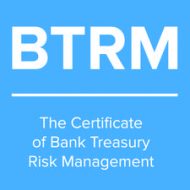The Certificate of Bank Treasury Risk Management (BTRM)
Starts 2nd October 2024
The world’s most comprehensive career-enhancing professional Bank Treasury / ALM qualification.
The BTRM is a truly global qualification, educating professionals in over 80 countries. Over 1000 alumni have now chosen the BTRM, valued by employers throughout the world.
- Students are awarded the prestigious BTRM certificate
- A Certificate of Advanced Studies (CAS) from University of Northwestern Switzerland (FHNW)
- 40 lectures over 5 modules.
- Dedicated Faculty Support, available every step of the way.
- Student forum answered within 24 hours.
- Flexible dedicated webinar for each module.
- All lectures are recorded and can be accessed at any time in your personalised educational portal.
- Qualify from anywhere in the world, on a part-time basis with fuly flexible study options.
- Over 1000 alumni have now chosen the BTRM, in over 80 countries.
- Taught by practitioners for practitioners with expert teaching and support
- Acquire the knowledge, tools and techniques used by banks in the real world
- Highly valued by employers throughout the world.

The BTRM has partnered with University of Northwestern Switzerland (FHNW) to offer the programme jointly.
The Certificate of Bank Treasury Risk Management (BTRM) is a professional qualification and certification in bank Treasury, Capital Markets and balance sheet risk management. The programme is a 6-month modular qualification, with cohorts starting every April and October.
VOLUME DISCOUNT: If 2 or more people from your institution wish to take The BTRM course please contact us
REGIONAL OFFERS: Get in touch for offers in your geographic region

23 lecture weeks live in London or globally online.

10-12 learning hours per week. 2 – 3 hour lectures.

Module Assignments and 3-hour Examination
BTRM Alumni Stories
Michael Heath
“As someone who’s had to build a Treasury from the ground up, I can say that if you are looking to a career in Bank Treasury, the BTRM will provide strong foundations to help you succeed.”
Graham Leitch
“However, I also wanted to gain greater knowledge of Treasury products and issues related to risk management. This led me directly to the BTRM, where people I work with had previous connections and recommended it highly.”
Cristobal Chacon Gallavan
“It is a very interesting time to be working in this area of the financial markets and I am extending the knowledge I gained from the BTRM every day.”
Obtaining the BTRM is a solid demonstration of continuing professional advancement and one that will keep both you and your employer ahead of the competition. We are confident of the high quality and practical value of the BTRM. It is a privilege to be able to bring this programme to so many.

